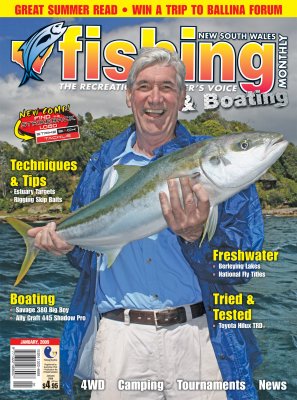Hitting the estuary target by Phil Bennett
 Of all the popular fishing environments it's our coastal rivers and lakes that attract the most anglers. This is largely due to our coastal way of life, with the vast majority of Aussie anglers living within an easy drive of a productive saltwater lake or river system.
Of all the popular fishing environments it's our coastal rivers and lakes that attract the most anglers. This is largely due to our coastal way of life, with the vast majority of Aussie anglers living within an easy drive of a productive saltwater lake or river system.
The consistency of quality fish available over the Summer months is also a large drawcard, with switched-on anglers consistently producing during the warmer months.
In this article we're going to look at the commonly targeted Summer species and where you should be looking for them.
FLATTIES
Of all the classic sun-loving fish, few are more fun to catch and tastier than the dusky flathead.
As the weather heats up, plenty of coastal anglers break out the light spin rods and target these feisty fish. Today there's an equal spilt between chasing them with lures and using bait. Both methods work, it's all a matter of preferred fishing style.
Whether you're a bait or lure angler, prime places to start looking for plate-sized flathead are the shallow, weed-lined lake and river edges.
Healthy weed beds are havens for marine life, attracting various baitfish and prawns, and the cagey flathead will often wait in ambush for an easy meal.
In non-tidal rivers and lakes, usually the most productive weed beds are those on any prominent points with deeper water fairly close by. The deeper water is often good travelling country for predatory fish and offers the flathead a good escape rout if need be.
Many weed beds are best fished from a drifting boat, because shore-based access can be limited and it's very easy to spook the fish.
Most keen flathead anglers fish from well set-up boats, with many sporting electric motors to help position the boat to cast or drift. Silently cruising around the points flicking baits and lures tight to the weed edges can be very productive, particularly around the prime feeding times of dawn and dusk.
In unfamiliar tidal systems you'll have do a little exploring, looking for prominent weed beds with a nice push of water at low tide. Drift very quietly over the tidal flats on high tide.
The basic idea is to land the lure or bait around the beds of ribbon weed, ideally on the sand patches in between. It's on these patches of clean ground where the flathead will often be lying, partly buried in the sand or silt just waiting for food, and a bait or lure sweeping by will seldom be refused.
In those estuaries not blessed with an abundance of weed, concentrate your efforts around the edges of sandy tidal flats, especially those choke points where channels narrow and drop off into deeper water. Flatties use these as ambush points to waylay baitfish passing on the tide.
If there's a high tide at first light, flathead often can be found right on the tops of the sandflats where they've spent the night sneaking up on baitfish foraging in the shallows.